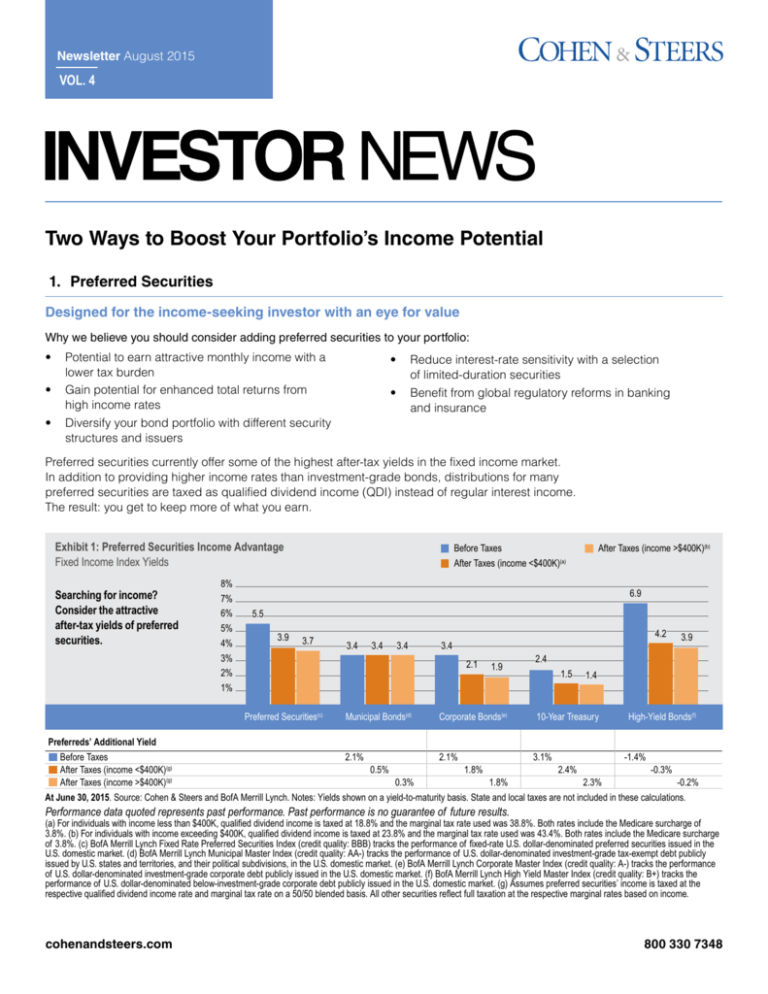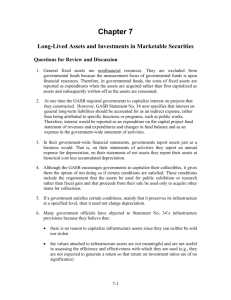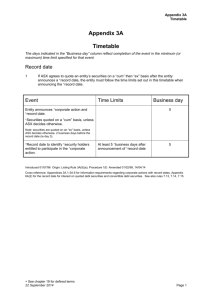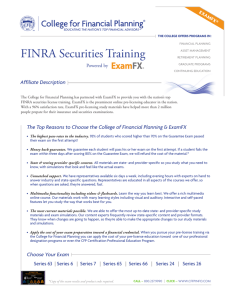
Newsletter June 2015
Newsletter August 2015
VOL. 4
VOL. 4
Two Ways to Boost Your Portfolio’s Income Potential
1. Preferred Securities
Designed for the income-seeking investor with an eye for value
Why we believe you should consider adding preferred securities to your portfolio:
• Potential to earn attractive monthly income with a
lower tax burden
• Gain potential for enhanced total returns from
high income rates
• Diversify your bond portfolio with different security
structures and issuers
• Reduce interest-rate sensitivity with a selection
of limited-duration securities
• Benefit from global regulatory reforms in banking
and insurance
Preferred securities currently offer some of the highest after-tax yields in the fixed income market.
In addition to providing higher income rates than investment-grade bonds, distributions for many
preferred securities are taxed as qualified dividend income (QDI) instead of regular interest income.
The result: you get to keep more of what you earn.
Exhibit 1: Preferred Securities Income Advantage
Fixed Income Index Yields
Searching for income?
Consider the attractive
after-tax yields of preferred
securities.
8%
7%
6%
5%
4%
3%
2%
1%
Before Taxes
After Taxes (income <$400K)(a)
After Taxes (income >$400K)(b)
6.9
5.5
3.9
3.7
4.2
3.4
3.4
3.4
3.4
2.1
Preferred Securities(c)
Municipal Bonds(d)
1.9
Corporate Bonds(e)
3.9
2.4
1.5
1.4
10-Year Treasury
High-Yield Bonds(f)
Preferreds’ Additional Yield
Before Taxes
2.1%
2.1%
3.1%
-1.4%
After Taxes (income <$400K)(g)
0.5%
1.8%
2.4%
-0.3%
After Taxes (income >$400K)(g)
0.3%
1.8%
2.3%
-0.2%
At June 30, 2015. Source: Cohen & Steers and BofA Merrill Lynch. Notes: Yields shown on a yield-to-maturity basis. State and local taxes are not included in these calculations.
Performance data quoted represents past performance. Past performance is no guarantee of future results.
(a) For individuals with income less than $400K, qualified dividend income is taxed at 18.8% and the marginal tax rate used was 38.8%. Both rates include the Medicare surcharge of
3.8%. (b) For individuals with income exceeding $400K, qualified dividend income is taxed at 23.8% and the marginal tax rate used was 43.4%. Both rates include the Medicare surcharge
of 3.8%. (c) BofA Merrill Lynch Fixed Rate Preferred Securities Index (credit quality: BBB) tracks the performance of fixed-rate U.S. dollar-denominated preferred securities issued in the
U.S. domestic market. (d) BofA Merrill Lynch Municipal Master Index (credit quality: AA-) tracks the performance of U.S. dollar-denominated investment-grade tax-exempt debt publicly
issued by U.S. states and territories, and their political subdivisions, in the U.S. domestic market. (e) BofA Merrill Lynch Corporate Master Index (credit quality: A-) tracks the performance
of U.S. dollar-denominated investment-grade corporate debt publicly issued in the U.S. domestic market. (f) BofA Merrill Lynch High Yield Master Index (credit quality: B+) tracks the
performance of U.S. dollar-denominated below-investment-grade corporate debt publicly issued in the U.S. domestic market. (g) Assumes preferred securities’ income is taxed at the
respective qualified dividend income rate and marginal tax rate on a 50/50 blended basis. All other securities reflect full taxation at the respective marginal rates based on income.
cohenandsteers.com
800 330 7348
Investor News August 2015
2. Real Estate Investment Trusts
Diversifying your portfolio with high-quality real estate
How real estate investment trusts (REITs) can help strengthen your portfolio:
• Potential to earn attractive dividend income in
investments structurally designed to grow distributions
• Gain potential for strong total returns derived
from income-producing properties
• Diversify your stock and bond holdings with the
potential to reduce portfolio volatility over time
• Participate in local economic growth through
investments in offices, apartments, shopping
centers, hotels and other real estate
At Cohen & Steers, we focus on investing in real estate companies that we believe are attractively
priced relative to the value of their property holdings and their projected cash flows. Many of these
companies are dominant participants in their markets and have superior management teams. We are
positioned for modest U.S. economic expansion and continued growth in demand. Below are a few
examples of property types in which real estate investment trusts can invest.
Shopping Centers—Developers Diversified Realty,
Village at Stone Oak, San Antonio, TX
Regional Malls—Simon Property Group
The Galleria, Houston, TX
Industrial—Prologis Inc.
Tejon Ranch, Lebec, CA
Hotels—Host Hotels & Resorts, Inc.
The Ritz Carlton, Amelia Island, FL
Self Storage—Public Storage
Located across the United States
Apartments—Equity Residential
425 Mass Apartments, Washington D.C.
Cohen & Steers Open-End Funds
Fund Name & Objective
Symbols
Cohen & Steers Real Assets Fund
The investment objective is to achieve attractive long-term
total returns and maximize real returns during inflationary
environments by investing in “real assets”—global real estate
companies, commodities, natural resource companies, global
infrastructure companies, gold and other precious metals.
RAPAX,
RAPCX,
RAPIX,
RAPRX,
RAPZX
CSEIX,
CSCIX,
CSDIX,
CIRRX,
CSZIX
CSRIX
CSRSX
Distributed by Cohen & Steers Securities, LLC.
DVFAX,
DVFCX,
DVFIX,
DVFRX,
DVFZX
The investment objective is to achieve total return through
investments in U.S. and non-U.S. equity securities issued
by infrastructure companies—those that typically provide a
physical framework defined as utilities, pipelines, toll roads,
airports, railroads, marine ports and telecommunications
companies.
CSUAX,
CSUCX,
CSUIX,
CSURX,
CSUZX
The investment objective is to achieve total return through
high current income and capital appreciation by investing in
preferred and debt securities issued by U.S. and non-U.S.
companies. Issuers include banks, insurance companies,
REITs and other diversified financials, as well as utility,
energy, pipeline and telecommunications companies.
CPXAX,
CPXCX,
CPXIX,
CPRRX,
CPXZX
Cohen & Steers MLP & Energy Opportunity Fund
GRSIX
Cohen & Steers Global Realty Shares
The investment objective is to achieve total return through
investment in global real estate equity securities, including
common stocks and other equity securities issued by U.S.
and non-U.S. real estate companies in REIT and similar
REIT-like structures.
The investment objectives are long-term growth of income
and capital appreciation achieved by investing in largecapitalization dividend-paying common stocks and preferred
stocks. The Fund’s value approach seeks investments that
appear undervalued but have good prospects for capital
appreciation and dividend growth.
Cohen & Steers Preferred Securities and Income Fund
Cohen & Steers Institutional Global Realty Shares
The investment objective is to achieve total return through
investment in global real estate equity securities, including
common stocks and other equity securities issued by U.S.
and non-U.S. real estate companies in REIT and similar
REIT-like structures.
IRFAX,
IRFCX,
IRFIX
Cohen & Steers Global Infrastructure Fund
Cohen & Steers Realty Shares
The investment objective is to achieve total return through
investment in real estate securities, including common
stocks, preferred stocks and other equity securities, as well
as debt securities issued by real estate companies in REIT
and REIT-like structures.
The investment objective of the Fund is to achieve total
return through investment in non-U.S. real estate equity
securities, including common stocks and other equity
securities issued by real estate companies in REIT and
REIT-like structures.
Cohen & Steers Dividend Value Fund
Cohen & Steers Institutional Realty Shares
The investment objective is to achieve total return through
investment in real estate securities, including common
stocks, preferred stocks and other equity securities, as well
as debt securities issued by real estate companies in REIT
and REIT-like structures.
Symbols
Cohen & Steers International Realty Fund
Cohen & Steers Real Estate Securities Fund
The investment objective is to achieve total return through
investment in real estate securities, including common
stocks, preferred stocks and other equity securities, as well
as debt securities issued by real estate companies.
Fund Name & Objective
The investment objective is attractive total return through
investments in energy-related master limited partnerships
(MLPs) and securities of companies that derive at least 50%
of their revenues or operating income from the exploration,
production, gathering, transportation, processing, storage,
refining, distribution or marketing of natural gas, crude oil
and other energy resources.
MLOAX,
MLOCX,
MLOIX,
MLORX,
MLOZX
Cohen & Steers Active Commodities Strategy Fund
CSFAX,
CSFCX,
CSSPX,
GRSRX,
CSFZX
The investment objective is to achieve attractive total
return by investing primarily in exchange-traded commodity
futures contracts and other commodity-related derivative
instruments across principal market sectors including energy,
industrial metals, agricultural, livestock and precious metals.
CDFAX,
CDFCX,
CDFIX,
CDFRX,
CDFZX
Please consider the investment objectives, risks, charges and expenses of the fund carefully before investing. A summary prospectus and prospectus
containing this and other information can be obtained by calling 800 330 7348 or by visiting cohenandsteers.com. Please read the summary prospectus
and prospectus carefully before investing.
Investor News August 2015
Important Disclosures
Performance data quoted represents past performance. Past performance is no guarantee of future results. The views and opinions in the preceding commentary
are as of the date of publication and are subject to change without notice. There is no guarantee that any historical trend illustrated herein will be repeated in the future, and there is no
way to predict precisely when such a trend will begin. There is no guarantee that any market forecast made in this commentary will be realized. This material represents an assessment
of the market environment at a specific point in time, should not be relied upon as investment or tax advice and is not intended to predict or depict performance of any investment. We
consider the information in this commentary to be accurate, but we do not represent that it is complete or should be relied upon as the sole source of suitability for investment. Investors
should consult their own advisors with respect to their individual circumstances. The information presented herein does not reflect the performance of any fund or other account managed
or serviced by Cohen & Steers, and there is no guarantee that investors will experience the type of performance reflected herein. An investor cannot invest directly in an index and index
performance does not reflect the deduction of any fees, expenses or taxes.
Risks of Investing in Preferred Securities. Investing in any market exposes investors to risks. In general, the risks of investing in preferred securities
are similar to those of investing in bonds, including credit risk and interest-rate risk. As nearly all preferred securities have issuer call options, call risk and
reinvestment risk are also important considerations. In addition, investors face equity-like risks, such as deferral or omission of distributions, subordination
to bonds and other more senior debt, and higher corporate governance risks with limited voting rights. Risks associated with preferred securities differ from
risks inherent with other investments. In particular, in the event of bankruptcy, a company’s preferred securities are senior to common stock but subordinated
to all other types of corporate debt. It is important to note that corporate bonds sit higher in the capital structure than preferred securities, and therefore in the
event of bankruptcy will be senior to the preferred securities. Municipal bonds are issued and backed by state and local governments and their agencies, and
the interest from municipal securities is often free from both state and local income taxes. Corporate bonds sit higher in the capital structure and therefore in
the event of bankruptcy will be senior to preferred securities. High-yield bonds, although typically issued by different types of issuers than those that issue
preferred securities and rated below investment grade, also would sit higher in a firm’s capital structure than preferred securities if the issuer did employ both
forms of issuance. 10-Year Treasury bonds are issued by the U.S. government and are generally considered the safest of all bonds since they’re backed
by the full faith and credit of the U.S. government as to timely payment of principal and interest. Below-investment-grade securities or equivalent unrated
securities generally involve greater volatility of price and risk of loss of income and principal, and may be more susceptible to real or perceived adverse
economic and competitive industry conditions than higher-grade securities.
Risks of Investing in Real Estate Securities. Risks of investing in real estate securities are similar to those associated with direct investments in real
estate, including falling property values due to increasing vacancies or declining rents resulting from economic, legal, political or technological developments;
lack of liquidity; limited diversification; and sensitivity to certain economic factors such as interest rate changes and market recessions. No representation or
warranty is made as to the efficacy of any particular strategy or fund or the actual returns that may be achieved.
About Cohen & Steers
Cohen & Steers is a global investment manager specializing in liquid real assets, including real estate securities, listed
infrastructure, commodities and natural resource equities, as well as preferred securities and other income solutions. Founded
in 1986, the firm is headquartered in New York City, with offices in London, Hong Kong, Tokyo and Seattle.
Copyright © 2015 Cohen & Steers, Inc. All rights reserved.
cohenandsteers.com
800 330 7348
INV004 0815







